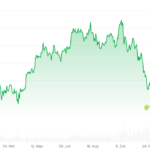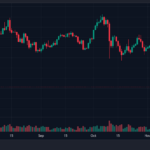- Joseph Lubin, co-founder of Ethereum, is predicting that Wall Street financial firms will begin operating directly on Ethereum’s infrastructure, running validators and launching their own Layer-2 and Layer-3 blockchains.
- Lubin’s optimistic outlook is supported by a significant increase in institutional adoption this year, with companies like Bitmine Immersion and SharpLink accumulating nearly 3% of all circulating ETH into their treasuries.
- Despite historical data showing September as a weak month for Ethereum, Lubin and Fundstrat’s Tom Lee remain confident that ETH could reach new peaks, potentially US$15,000 by the end of 2025.
Consensys CEO and Ethereum co-founder, Joseph Lubin, is more bullish than ever when it comes to Ethereum.
In a recent post on X, Lubin backed Fundstrat’s Tom Lee and his projection of Ethereum’s expanding role at the core of global finance, arguing that major financial firms will soon operate directly on Ethereum’s infrastructure.
According to Lubin, Wall Street banks will run validators, launch L2s and L3s, and write smart contracts to migrate their business systems onto Ethereum.
Yes, Wall Street will stake because they currently pay for their infrastructure and Ethereum will replace much of the many siloed stacks they operate on (…) They will need to become a TradFi company that operates on decentralized rails, and that means staking, running validators, operating L2s/L3s/etc, participating in DeFi and writing smart contract software for agreements, processes and financial instruments, etc.
Related: Aave Labs Unveils Horizon to Bring Stablecoin Borrowing Backed by Tokenised Treasuries
Lubin put JPMorgan as an example, stating that the investment giant has already spent nearly a decade experimenting with Ethereum-based technology for permissioned blockchain projects. Goldman Sachs, Onyx, and other institutions are now rolling out stablecoin and DeFi initiatives on Ethereum.
Overall, institutional adoption has accelerated in 2025. Since June, companies such as Bitmine Immersion and Sharplink (of which Lubin is also a chairman) have moved nearly 3% of all circulating ETH into their corporate treasuries.
Together they now hold more than US$6B (AU$9.1B) in ETH.
September: Bullish Or Bearish?
As Crypto News Australia reported, September is, more often than not, a troublesome month for most cryptocurrencies because volatility usually looms. Just to get an idea, since 2016, September has been Ethereum’s worst month on record, with an average return of -6.42%.
And after a 76% year-to-date surge and nearly 25% in August alone, the probability of profit-taking increases.
But both Lubin and Lee are optimistic about ETH (and the general market), stating that Ethereum’s fundamentals can outweigh even the harshest of monetary policies and macro factors, citing Institutional inflows, treasury adoption, staking yields, and network upgrade.
The one quibble that I have with what Tom has been saying, and I keep telling him this: he is not nearly bullish enough. But the real problem is that it is not possible to be bullish enough.
 Josepth Lubin, CEO of Consensys
Josepth Lubin, CEO of Consensys For his part, Lee also echoed the institutional sentiment, stating that Ethereum could reach US$15K (AU$23K) by the end of 2025, citing adoption, stablecoin regulation, etc.
Ethereum is currently trading at US$4.3K (AU$6.58K), a decrease of 8.2% in the last week, as per CoinGecko data.

Related: XRP Price: Chinese Linklogis Brings Supply Chain Finance to XRPL
The post Ethereum’s Next 100x? ConsenSys CEO Sees Wall Street Convergence appeared first on Crypto News Australia.





